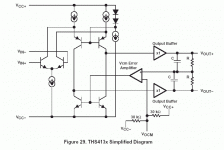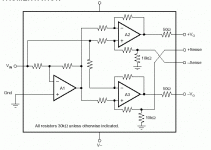So according to TI, these new fully differential I/O amplifiers, like OPA1632 is the best thing since sliced bread, and when I look at their datasheet I tend to agree.
The deal is this: "Differential output reduces even-order harmonics and minimizes common-mode noise interference."
So I start thinking, why haven't we seen this before? Smart people must have thought of this long ago. And if so why aren't there any discrete power amplifiers out there based on this? Or maybe there is but I haven't found them yet.
Anyone knows? Is it something worth pursuing?
Here is the diagram of the THS4131 amp:
The deal is this: "Differential output reduces even-order harmonics and minimizes common-mode noise interference."
So I start thinking, why haven't we seen this before? Smart people must have thought of this long ago. And if so why aren't there any discrete power amplifiers out there based on this? Or maybe there is but I haven't found them yet.
Anyone knows? Is it something worth pursuing?
Here is the diagram of the THS4131 amp:
Attachments
ojg said:So I start thinking, why haven't we seen this before?
i guess we all have seen this before , its good for balanced inputs etc but thats the only application i can think off
Differential output
Hi ojg,
Push pull amplifiers (tube & transistor) do this. Tube types have been doing this since before many of us were born. Of course, as sss pointed out, the studio standard balanced out does this too. There are only some situations where this is a benefit, like long cable runs or really noisy (electrically) enviroments.
-Chris
Hi ojg,
Push pull amplifiers (tube & transistor) do this. Tube types have been doing this since before many of us were born. Of course, as sss pointed out, the studio standard balanced out does this too. There are only some situations where this is a benefit, like long cable runs or really noisy (electrically) enviroments.
-Chris
Re: Differential output
Why is "reduction of even-order harmonics and minimized common-mode noise interference" only a good thing when you have long cable runs?
Back to my point. These amplifiers seem (to me at least) different from the regular balanced output drivers such as
DRV135 (see attachment)
The THS4131 looks rather normal at the input, a regular diff input stage with folded cascode. The peculiarity is that there are two output buffers in opposite phase. There are two sets of feedback networks one from each buffer to each side of the diff input stage. In addition there is a "servo" to cancel common-mode errors. This is also different from a normal bridged amplifier.
If this has been used in tube circuits before I am interested in seeing a schematic (even though I know nothing about tube design...)
anatech said:There are only some situations where this is a benefit, like long cable runs or really noisy (electrically) enviroments.
Why is "reduction of even-order harmonics and minimized common-mode noise interference" only a good thing when you have long cable runs?
Back to my point. These amplifiers seem (to me at least) different from the regular balanced output drivers such as
DRV135 (see attachment)
The THS4131 looks rather normal at the input, a regular diff input stage with folded cascode. The peculiarity is that there are two output buffers in opposite phase. There are two sets of feedback networks one from each buffer to each side of the diff input stage. In addition there is a "servo" to cancel common-mode errors. This is also different from a normal bridged amplifier.
If this has been used in tube circuits before I am interested in seeing a schematic (even though I know nothing about tube design...)
Attachments
Actually, the even order harmonics are cancelled when the opposite phases are combined ... like in an output transformer of a tube amp. The same occurs in the balanced input which could be a transformer or differential pair.
Otherwise, you have the same distortion spectrum (no cancellation).
A long cable run is an application of the noise cancelling property of a balanced output. I should have made that more clear.
-Chris
Otherwise, you have the same distortion spectrum (no cancellation).
A long cable run is an application of the noise cancelling property of a balanced output. I should have made that more clear.
-Chris
I've already posted on this subject a couple of weeks ago:
http://www.diyaudio.com/forums/showthread.php?s=&threadid=35775
Cheers
x-pro
http://www.diyaudio.com/forums/showthread.php?s=&threadid=35775
Cheers
x-pro
x-pro:
I saw your post earlier, but thought the subject was worthy of more discussion!
Petter:
I need to study the X circuit closer, but I thought it used two amplifiers in a "sort of" bridged mode? Similiar but not quite the same? There's been many X threads in the Pass forum but which one discussed the theory behind this?
anatech:
I know the even harmonics are cancelled when you combine the opposite phases. If that is all there is to it then the DRV135 and other bridged amplifiers should have equally impressive specs, but they don't.
Also noteworthy is that the OPA1632 has only 78dB of open-loop gain, very low by audio standards. (OPA134 has 120dB!) So the low distortion is not due to large amounts of NFB.
I have a feeling that the trick is having the feedback from each output buffer return to a single differential input pair, but I can't prove it...
I saw your post earlier, but thought the subject was worthy of more discussion!
Petter:
I need to study the X circuit closer, but I thought it used two amplifiers in a "sort of" bridged mode? Similiar but not quite the same? There's been many X threads in the Pass forum but which one discussed the theory behind this?
anatech:
I know the even harmonics are cancelled when you combine the opposite phases. If that is all there is to it then the DRV135 and other bridged amplifiers should have equally impressive specs, but they don't.
Also noteworthy is that the OPA1632 has only 78dB of open-loop gain, very low by audio standards. (OPA134 has 120dB!) So the low distortion is not due to large amounts of NFB.
I have a feeling that the trick is having the feedback from each output buffer return to a single differential input pair, but I can't prove it...
ojg said:Also noteworthy is that the OPA1632 has only 78dB of open-loop gain, very low by audio standards. (OPA134 has 120dB!) So the low distortion is not due to large amounts of NFB.
More important that this 78 dB gain is the same almost over all audio frequency band, but "120 dB of gain" in OPA134 is only valid for very low frequencies- at 10 kHz it has only about 60 dB gain - almost 20 dB lower than THS4131 (or OPA1632)
x-pro
But How does it sound???
The specific differences (by ommission) between the THS4131 and the OPA1632 appears to be the common range input offset, +-6v vs +-3V.
This might be a result of a different architectural method of dealing with the Ocm pin,
The THS41x1 uses a rather 'trick' method, that might be absent in the newer OPA.
http://www.diyaudio.com/forums/showthread.php?postid=14435#post14435
The specific differences (by ommission) between the THS4131 and the OPA1632 appears to be the common range input offset, +-6v vs +-3V.
This might be a result of a different architectural method of dealing with the Ocm pin,
The THS41x1 uses a rather 'trick' method, that might be absent in the newer OPA.
http://www.diyaudio.com/forums/showthread.php?postid=14435#post14435
Indeed!x-pro said:More important that this 78 dB gain is the same almost over all audio frequency band, but "120 dB of gain" in OPA134 is only valid for very low frequencies- at 10 kHz it has only about 60 dB gain - almost 20 dB lower than THS4131 (or OPA1632)
I think Petter led me onto the right track. I have now read Pass' whitepaper and his patent on Su-Sy and I can see that there are clearly similarities in how the distortion from each output buffer is combined in the input stage. What also contributes to low distortion is the near perfect matching that TI can achieve between the output stage transistors in an IC.
Question is: Are the implementations different enough that they don't infringe on Pass' patent?
Re: But How does it sound???
Not offset but maximum rated input differential voltage. I suspect it has nothing to do with the Ocm (which is controlling the output). There is one more notable difference - current noise on OPA1632 is about 3 times lower that that on THS4131. Perhaps they change the input stage a bit to get lower noise and as a result got lower max diff. voltage. Otherwise these two do appear identical... .
x-pro
pmkap said:The specific differences (by ommission) between the THS4131 and the OPA1632 appears to be the common range input offset, +-6v vs +-3V.
This might be a result of a different architectural method of dealing with the Ocm pin,
The THS41x1 uses a rather 'trick' method, that might be absent in the newer OPA.
http://www.diyaudio.com/forums/showthread.php?postid=14435#post14435
Not offset but maximum rated input differential voltage. I suspect it has nothing to do with the Ocm (which is controlling the output). There is one more notable difference - current noise on OPA1632 is about 3 times lower that that on THS4131. Perhaps they change the input stage a bit to get lower noise and as a result got lower max diff. voltage. Otherwise these two do appear identical... .
x-pro
Hey.....wait a minute.......
I designed a preamp, back in........'88(?) that looked just like this.
Except it used JFETs in the front-end, and I ran it open loop.
Sounded pretty good............
But since you asked about power amps........
Check out the LM6313, if it is still on National's site.
(Thanks to Charlie Hansen for pointing this out several years after I made the first one..............)
Jocko
I designed a preamp, back in........'88(?) that looked just like this.
Except it used JFETs in the front-end, and I ran it open loop.
Sounded pretty good............
But since you asked about power amps........
Check out the LM6313, if it is still on National's site.
(Thanks to Charlie Hansen for pointing this out several years after I made the first one..............)
Jocko
Re: Go after 'em......!
That's the problem with huge companies, they can simply ignore patents from small companies because their army of lawyers know how to drag the case out on technicalities (no pun intended), making a lawsuit far too expensive.
IMO, patents by small companies are only effective against other small companies, such as between hifi manufacturers.
Jocko Homo said:If anyone is deserving, they are.
Unless it costs too much $$$.
That's the problem with huge companies, they can simply ignore patents from small companies because their army of lawyers know how to drag the case out on technicalities (no pun intended), making a lawsuit far too expensive.
IMO, patents by small companies are only effective against other small companies, such as between hifi manufacturers.
You don't have to look too far to find fully differential amplifiers from other manufacturers,
http://cache.national.com/ds/LM/LM4895.pdf
AD8139
LT6600-20
LTC1992
Would these also infringe on Nelson Pass's Patent? I guess there isn't enough information in the datasheets to say for sure.
http://cache.national.com/ds/LM/LM4895.pdf
AD8139
LT6600-20
LTC1992
Would these also infringe on Nelson Pass's Patent? I guess there isn't enough information in the datasheets to say for sure.
- Status
- This old topic is closed. If you want to reopen this topic, contact a moderator using the "Report Post" button.
- Home
- Amplifiers
- Solid State
- Fully differential I/O amplifier

